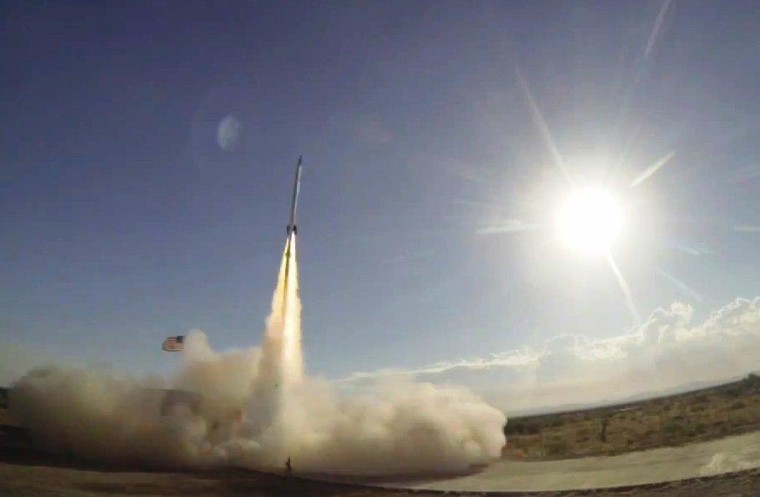A suborbital sounding rocket launched seven space-technology experiments — plus some unusual commercial payloads — from New Mexico's Spaceport America on Friday.
The 20-foot-tall (6-meter-tall) UP Aerospace SpaceLoft XL rocket rose into the sky just before 8 a.m. MT (10 a.m. ET), reached an altitude of 73.9 miles and descended back to Earth, NASA reported. The rocket and its payloads were recovered intact from the U.S. Army's White Sands Missile Range, 23.5 miles (37.8 kilometers) downrange, New Mexico's Spaceport Authority said.
"Everything went as planned," Christine Anderson, the Spaceport Authority's executive director, told the Albuquerque Journal.
NASA funded the flight for the seven experiments, which were given a few minutes of weightlessness for spaceflight testing. Those payloads included:
- The Federal Aviation Administration's Automatic Dependent Surveillance-Broadcast device, or ADS-B, which is designed for use in air traffic control and related applications. Current plans call for all aircraft operating in U.S. airspace to be equipped with ADS-B tracking devices by 2020. Another payload provided raw GPS data as a position source for ADS-B experiment.
- Italian DTM Technology's Diapason instrument, which monitors nanoparticle migration and capture. Diapason is designed to measure combustion-generated pollution, air content in hostile environments and atmospheric contaminants.
- Two packages filled with experiments prepared by high-school classes and arranged through the New Mexico Space Grant Consortium.
- An inertial measurement unit and data logger, as well as an experimental package that monitored environmental parameters during the flight.
The launch was part of NASA's Flight Opportunities Program, which provides suborbital payload launch resources for governmental projects as well as educational institutions and the private sector.
In addition to the experimental payloads, the SpaceLoft rocket carried containers holding small samples of the cremated remains from 36 people. That payload was put together by a Houston-based company called Celestis that specializes in memorial spaceflights. Among those whose ashes flew on Friday's flight were Judd Nordyke, the late mayor of Hatch, N.M.; and Maria Sabaliauskas Swan, a former New Mexico resident who was Miss Argentina in 1967.
Additional space on the rocket was sold to send commercial items into space and back. The Las Cruces Sun-News reported that those items included poker chips for a Harley-Davidson store, and fabric that will be made into yoga pants.
More about Spaceport America:
- SpaceX signs lease to launch in New Mexico
- NM spaceport is built, but who will come?
- NM governor signs space travel liability bill
Alan Boyle is NBCNews.com's science editor. Connect with the Cosmic Log community by "liking" the NBC News Science Facebook page, following @b0yle on Twitter and adding the Cosmic Log page to your Google+ presence. To keep up with NBCNews.com's stories about science and space, sign up for the Tech & Science newsletter, delivered to your email in-box every weekday. You can also check out "The Case for Pluto," my book about the controversial dwarf planet and the search for new worlds.
